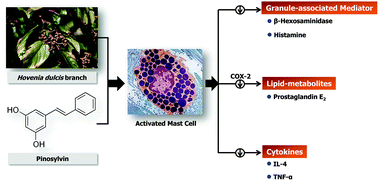Inhibitory effect of the branches of Hovenia dulcis Thunb. and its constituent pinosylvin on the activities of IgE-mediated mast cells and passive cutaneous anaphylaxis in mice
Abstract
Hovenia dulcis Thunb. (Rhamnaceae) is a hardy tree native to Europe, the Middle East, and North Africa, and it is also grown in parts of Asia and has been used in traditional medicine to treat liver toxicity, stomach disorders, and inflammation. This study investigated the anti-allergy potential of an extract of the branches of H. dulcis (HDB) using the antigen-stimulated mast cell-like cell line rat basophilic leukemia (RBL)-2H3 and a passive cutaneous anaphylaxis (PCA) mouse model. Degranulation assay, reverse transcription PCR, enzyme-lined immunosorbent assays, western blot analyses, and PCA were performed to measure allergic responses and proinflammatory mediators in antigen-stimulated rat basophilic leukemia (RBL)-2H3 mast cells and the PCA mouse model. In antigen-stimulated RBL-2H3 cells, HDB inhibited the secretion of β-hexosaminidase (indicating the inhibition of degranulation) and histamine release; decreased expression and production of the inflammatory mediators, cyclooxygenase-2 and prostaglandin E2, and cytokines interleukin-4 and tumor necrosis factor-α; and suppressed activation of nuclear factor κB, a transcription factor involved in the response to cytokines. HDB attenuated phosphorylation of the mast cell downstream effectors Lyn, Syk, phospholipase Cγ, protein kinase Cμ, extracellular signal-regulated kinase and p38. In IgE-sensitized mice, HDB inhibited mast cell-dependent PCA. Furthermore, HDB contained pinosylvin and possessed significant anti-allergic activities. These results suggest that HDB would be of value in the prevention and treatment of allergic diseases.


 Please wait while we load your content...
Please wait while we load your content...